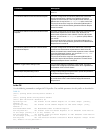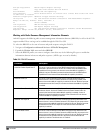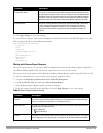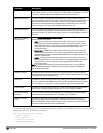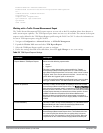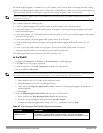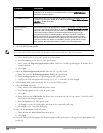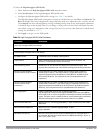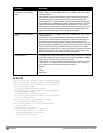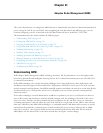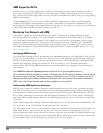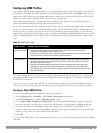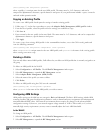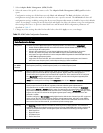
12. Select the High-throughput SSID Profile.
a. Select New from the High-throughput SSID Profile drop-down menu.
b. Enter ht-ssid-corpnet for the high-throughput SSID profile name.
c. Configure the high-throughput SSID profile settings (see Table 95 for details).
The High-Throughput SSID profile configuration settings are divided into two tabs, Basic and Advanced. The
Basic tab displays only those configuration settings that often need to be adjusted to suit a specific network.
The Advanced tab shows all configuration settings, including settings that do not need frequent adjustment
or should be kept at their default values. If you change a setting on one tab then click and display the other
tab without saving your configuration, that setting will revert to its previous value. Both basic and advanced
settings are described in Table 54.
d. Click Apply to assign it to the SSID profile.
Parameter Description
Basic High-Throughput SSID Profile Settings
40 MHz channel usage Enable or disable the use of 40 MHz channels. This parameter is enabled by default.
Advanced High-Throughput SSID Profile Settings
BA AMSDU Enable Enable/Disable Receive AMSDU in BA negotiation.
Legacy stations Allow or disallow associations from legacy (non-HT) stations. By default, this
parameter is enabled (legacy stations are allowed).
Low-density Parity Check If enabled, the AP will advertise Low-density Parity Check (LDPC) support. LDPC
improves data transmission over radio channels with high levels of background noise.
Maximum number of spatial
streams usable for STBC reception
Controls the maximum number of spatial streams usable for STBC reception. 0
disables STBC reception, 1 uses STBC for MCS 0-7. Higher MCS values are not
supported. (Supported on the W-AP90 series, W-AP130 Series, W-AP68, W-AP175
Series and W-AP105 only. The configured value will be adjusted based on AP
capabilities.)
Maximum number of spatial
streams usable for STBC
transmission.
Controls the maximum number of spatial streams usable for STBC transmission. 0
disables STBC transmission, 1 uses STBC for MCS 0-7. Higher MCS values are not
supported. (Supported on W-AP90 series, W-AP175 Series, W-AP130 Seriesand W-
AP105 only. The configured value will be adjusted based on AP capabilities.)
MPDU Aggregation Enable or disable MAC protocol data unit (MPDU) aggregation.
High-throughput APs are able to send aggregated MAC protocol data units (MDPUs),
which allow an AP to receive a single block acknowledgment instead of multiple ACK
signals. This option, which is enabled by default, reduces network traffic overhead by
effectively eliminating the need to initiate a new transfer for every MPDU.
Max received A-MPDU size Maximum size of a received aggregate MPDU, in bytes. Allowed values: 8191, 16383,
32767, 65535.
Max transmitted A-MPDU size Maximum size of a transmitted aggregate MPDU, in bytes.
Range: 1576–65535
Min MPDU start spacing Minimum time between the start of adjacent MPDUs within an aggregate MPDU, in
microseconds. Allowed values: 0 (No restriction on MDPU start spacing), .25 µsec, .5
µsec, 1 µsec, 2 µsec, 4 µsec.
Table 95:
High-Throughput SSID Profile Parameters
DellPowerConnectW-SeriesArubaOS6.2 | User Guide VirtualAPs | 343



